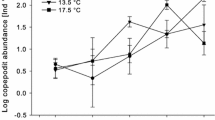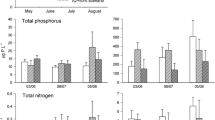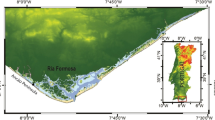Abstract
The response of the Baltic Sea spring bloom was studied in mesocosm experiments, where temperatures were elevated up to 6°C above the present-day sea surface temperature of the spring bloom season. Four of the seven experiments were carried out at different light levels (32–202 Wh m−2 at the start of the experiments) in the different experimental years. In one further experiment, the factors light and temperature were crossed, and in one experiment, the factors density of overwintering zooplankton and temperature were crossed. Overall, there was a slight temporal acceleration of the phytoplankton spring bloom, a decline of peak biomass and a decline of mean cell size with warming. The temperature influence on phytoplankton bloom timing, biomass and size structure was qualitatively highly robust across experiments. The dependence of timing, biomass, and size structure on initial conditions was tested by multiple regression analysis of the y-temperature regressions with the candidate independent variables initial light, initial phytoplankton biomass, initial microzooplankton biomass, and initial mesozooplankton (=copepod) biomass. The bloom timing predicted for mean temperatures (5.28°C) depended on light. The peak biomass showed a strong positive dependence on light and a weaker negative dependence on initial copepod density. Mean phytoplankton cell size predicted for the mean temperature responded positively to light and negatively to copepod density. The anticipated mismatch between phytoplankton supply and food demand by newly hatched copepod nauplii occurred only under the combination of low light and warm temperatures. The analysis presented here confirms earlier conclusions about temperature responses that are based on subsets of our experimental series. However, only the comprehensive analysis across all experiments highlights the importance of the factor light.






Similar content being viewed by others
References
Aberle N, Lengfellner K, Sommer U (2007) Spring bloom succession, grazing impact and herbivore selectivity of ciliate communities in response to winter warming. Oecologia 150:668–681
Atkinson D, Ciotti BJ, Montagnes DJS (2003) Protist decrease in size linearly with temperature: ca. 2.5% °C. Proc R Soc Lond B 270:2605–2611
Boyce DG, Lewis MR, Worm B (2010) Global phytoplankton decline over the past century. Nature 466:591–596
Brock TD (1981) Calculating solar radiation for ecological models. Ecol Model 14:1–19
Cleland EE, Chuine I, Menzel A, Mooney HA, Schwartz MD (2007) Shifting plant phenology in response to global change. Trends Ecol Evol 22:357–366
Cushing DH (1990) Plankton production and year-class strength in fish populations—an update of the match-mismatch hypothesis. Adv Mar Biol 26:249–293
Daufresne M, Lengfellner K, Sommer U (2009) Global warming benefits the small in aquatic ecosystems. Proc Natl Acad Sci 106:12788–12793
Edwards M, Beaugrand G, Reid PC, Rowden A, Jones MB (2002) Ocean climate anomalies and the ecology of the North Sea. Mar Ecol Prog Ser 239:1–10
Eppley RW (1972) Temperature and phytoplankton growth in the sea. Fish Bull 70:1063–1085
Gaedke U, Ruhenstroth-Bauer M, Wiegand I, Tirok K, Aberle N, Breithaupt P, Lengfellner K, Wohlers J, Sommer U (2010) Biotic interactions may overrule direct climate effects on spring phytoplankton dynamics. Glob Change Biol 16:1122–1136
Gardner JL, Peters A, Kearney MR, Joseph L, Heinsohn R (2011) Declining body size: a third universal response to warming? Trends Ecol Evol 26:285–291
Gerten D, Adrian R (2001) Differences in the persistency of the North Atlantic oscillation signal among lakes. Limnol Oceanogr 46:448–455
Hancke K, Glud RN (2004) Temperature effects on respiration and photosynthesis in three diatom-dominated benthic communities. Aquat Microb Ecol 37:265–281
Hillebrand H, Duerselen C-D, Kirschtel D, Pollingher U, Zohary T (1999) Biovolume calculation for pelagic and benthic microalgae. J Phycol 35:403–424
Hoppe HG, Breithhaupt P, Walther K, Koppe R, Bleck S, Sommer U, Jürgens K (2008) Climate warming in winter affects the coupling between phytoplankton and bacteria during the spring bloom. Aquat Microb Ecol 51:105–115
Huisman J, Sommeijer B (2002) Population dynamics of sinking phytoplankton in light-limited environments: simulation techniques and critical parameters. J Sea Res 48:83–96
Huisman J, Thi NNP, Karl DM, Sommeijer B (2005) Reduced mixing generates oscillations and chaos in the oceanic deep chlorophyll maximum. Nature 439:322–325
Ikeda T, Kanno Y, Ozaki K, Shinada A (2001) Metabolic rate of epipelagic copepods as a function of body mass and temperature. Mar Biol 139:587–596
IPCC (International Panel on Climate Change) (2007) Climate change 2007: the physical science basis. UNEP and WHO. Cambridge University Press, Cambridge
Isla A, Lengfellner K, Sommer U (2008) Physiological response of the copepod Pseudocalanus sp. in the Baltic Sea at different thermal scenarios. Glob Change Biol 14:895–906
Ivleva IV (1980) The dependence of crustacean respiration rate on body mass and habitat temperature. Int Rev Hydrobiol 65:1–47
Jacques G (1983) Some ecophysiological aspects of Antarctic phytoplankton. Polar Biol 2:27–33
Lewandowska A, Sommer U (2010) Climate change and the spring bloom: a mesocosm study on the influence of light and temperature on phytoplankton and mesozooplankton. Mar Ecol Prog Ser 405:101–111
Lewandowska A, Breithaupt P, Hillebrand H, Hoppe HG, Jürgens K, Sommer U (2011) Responses of primary productivity to increased temperature and phytoplankton diversity. J Sea Res. doi:10.1016/j.seares.2011.10.003
Menden-Deuer S, Lessard EJ (2000) Carbon to volume relationships for dinoflagellates, diatoms, and of the protist plankton. Limnol Oceanogr 45:569–579
Moran XA, Lopez-Urrutia A, Calvo-Diaz A, Li WKW (2010) Increasing importance of small phytoplankton in a warmer ocean. Glob Change Biol 16:1137–1144
Müren U, Berglund J, Samulesson K, Andersson A (2005) Potential effects of elevated sea-water temperature on pelagic food webs. Hydrobiologia 545:153–166
O’Connor ML, Piehler MF, Leech DM, Anton A, Bruno JF (2009) Warming and resource availability shift food web structure and metabolism. PLoS Biol 7(8):e1000178. doi:10.1371/journal.pbio.1000178
Prosser CL (1973) Comparative animal physiology. Saunders, London
Putt M, Stoecker DK (1989) An experimentally determined carbon: volume ratio for marine “oligotrichous” ciliates from estuarine and coastal waters. Limnol Oceanogr 34:1097–1103
Reynolds CS (1989) Physical determinants of phytoplankton succession. In: Sommer U (ed) Plankton succession. Brock-Springer, Madison, pp 9–56
Riley GA (1957) Phytoplankton of the North Central Sargasso Sea. Limnol Oceanogr 2:252–270
Ruprecht E, Schröder SS, Ubl S (2002) On the relation between NAO and water vapour transport towards Europe. Meteorol Z 11:395–401
Sand-Jensen K, Pedersen NL, Søndergaard M (2007) Bacterial metabolism in small temperate streams under contemporary and future climates. Freshw Biol 52:2340–2353
Smetacek V (1999) Diatoms and the ocean carbon cycle. Protist 150:25–32
Sommer U (1996) Plankton ecology: the last two decades of progress. Naturwissenschaften 83:293–301
Sommer U, Lengfellner K (2008) Climate change and the timing, magnitude and composition of the phytoplankton spring bloom. Glob Change Biol 14:1199–1208
Sommer U, Lewandowska A (2011) Climate change and the phytoplankton spring bloom: warming and overwintering zooplankton have similar effects on phytoplankton. Glob Change Biol 17:154–162
Sommer U, Sommer F (2006) Cladocerans versus copepods: the cause of contrasting top-down controls on freshwater and marine phytoplankton. Oecologia 147:183–194
Sommer U, Gliwicz ZM, Lampert W, Duncan A (1986) The PEG-model of seasonal succession of planktonic events in fresh waters. Arch Hydrobiol 106:433–471
Sommer U, Aberle N, Engel A, Hansen T, Lengfellner K, Sandow M, Wohlers J, Zöllner U, Riebesell U (2007) An indoor mesocosm system to study the effect of climate change on the late winter and spring succession of Baltic Sea phyto- and zooplankton. Oecologia 150:655–667
Stenseth NC, Mysterud A, Ottersen G, Hurrell JW, Chan KS, Lima M (2002) Ecological effects of climate fluctuations. Science 297:1292–1296
Stibor H, Vadstein O, Diehl S, Gelzleichter A, Hansen T, Hantzsche F, Katechakis A, Lippert B, Loeseth K, Peters C, Roederer W, Sandow M, Sundt-Hansen L, Olsen Y (2004) Copepods act as a switch between alternative marine food webs. Ecol Lett 7:321–328
Sverdrup H (1953) On conditions for the vernal blooming of phytoplankton. J Cons Explor Mer 18:287–295
Tilstone GH, Miguez BM, Figueiras FG, Fermin EG (2000) Diatom dynamics in a coastal ecosystem affected by upwelling: coupling between species succession, circulation and biogeochemical processes. Mar Ecol Prog Ser 205:23–41
Tilzer MM, Elbrächter M, Gieskes W, Beese B (1986) Light-temperature interactions in the control of photosynthesis in Antarctic phytoplankton. Polar Biol 5:105–111
Tirok K, Gaedke U (2007) The effect of irradiance, vertical mixing and temperature on spring phytoplankton dynamics under climate change: long-term observations and model analysis. Oecologia 150:625–642
Visser ME, van Noordwijk AJ, Tinbergen JM, Lessells CM (1998) Warmer springs lead to mistimed reproduction in great tits (Parus major). Proc R Soc Lond Ser B 265:1867–1870
Walther GR, Post E, Convey P et al (2002) Ecological responses to recent climate change. Nature 416:389–395
Wasmund N, Göbel J, von Bodungen B (2008) 100-years-changes in the phytoplankton community of Kiel Bight (Baltic Sea). J Mar Syst 73:300–322
Weyhenmeyer GA (2001) Warmer winters: are planktonic populations in Sweden’s largest lake affected? Ambio 30:565–571
Weyhenmeyer GA, Blenckner T, Pettersson K (1999) Changes of the plankton spring outburst related to the North Atlantic oscillation. Limnol Oceanogr 44:1788–1792
Wiltshire KH, Manly BFJ (2004) The warming trend at Helgoland Roads, North Sea: phytoplankton response. Helgol Mar Res 58:269–273
Wiltshire KH, Malzahn AM, Wirtz K, Greve W, Janisch S, Mangelsdorf P, Manly BFJ, Boersma M (2008) Resilience of North Sea phytoplankton spring bloom dynamics: an analysis of long-term data at Helgoland Roads. Limnol Oceanogr 53:1294–1302
Wohlers J, Engel A, Zöllner E, Breithaupt P, Jürgens K, Hoppe HG, Sommer U, Riebesell U (2009) Changes in biogenic carbon flow in response to sea surface warming. Proc Natl Acad Sci 106:7067–7072
Zhang X, Zwiers FW, Hegerl GC, Lambert FH, Gillet NP, Solomon S, Stott PA, Nozawa T (2007) Detection of human influence on twentieth-century precipitation trends. Nature 448:461–465
Acknolwedgements
The experiments reported here were funded via the priority program 1162 (“AQUASHIFT”) by Deutsche Forschungsgemeinschaft (DFG). Technical assistance by Thomas Hansen, Cordula Meyer and Bente Gardeler are gratefully acknowledged.
Author information
Authors and Affiliations
Corresponding author
Additional information
Communicated by R. Adrian.
Rights and permissions
About this article
Cite this article
Sommer, U., Aberle, N., Lengfellner, K. et al. The Baltic Sea spring phytoplankton bloom in a changing climate: an experimental approach. Mar Biol 159, 2479–2490 (2012). https://doi.org/10.1007/s00227-012-1897-6
Received:
Accepted:
Published:
Issue Date:
DOI: https://doi.org/10.1007/s00227-012-1897-6




